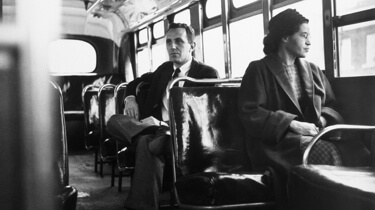 Exercise
Exercise
Tap all the highlighted words in the story below to see their definition. ⇩On May 25, 2020 in Minneapolis, Minnesota, an unarmed man named George Floyd was killed by a white police officer. Protests and riots began the next day.
This incident is just one of many in a long history of racism. Slavery was abolished in the United States 155 years ago, yet African Americans are still not treated equally.
Fighting for equality
African Americans’ endless fight for social and political equality (civil rights) really began in the 1950s. Here are a few events that sparked social change.
Montgomery Bus Boycott
In Alabama on December 1, 1955, a black woman named Rosa Parks sat at the front of a public bus (where only whites were allowed). She wouldn’t move to the back and was arrested. In response, a group led by social activist and Baptist minister Martin Luther King Jr. staged a boycott until segregation on buses ended.
Little Rock Nine
In 1957, after public schools were desegregated, a group of nine black students registered in a formerly white school in Little Rock, Arkansas. The students were threatened by violence and forced to leave. Ultimately, they were escorted into the school by military troops. These nine students became a symbol of educational equality.

Greensboro Sit-ins
On February 1, 1960, four black college students refused to leave a segregated lunch counter in North Carolina until they were served. Hundreds joined sit-ins over the next few days and protests took place across the country; many were arrested. By the summer, lunch counters in the south had begun to desegregate.
Birmingham Campaign
In spring of 1963, peaceful protests took place to end segregation in Birmingham, Alabama. More than 1,000 black children who had joined the protests were attacked by police dogs and knocked down by high-pressure water from hoses. These protests got national attention and segregation began to break down.
March on Washington
On August 28, 1963, more than 200,000 people marched on Washington, D.C. to fight for civil rights and job equality. At this rally, Martin Luther King Jr. made his famous speech, “I Have a Dream.” This demonstration led the Civil Rights Act in 1964.
The fight isn’t over
There’s still a lot of work to do. To show your support, remember to listen, learn, and raise your voice against injustice.
Feeling overwhelmed? Here’s a reading list to get you started:
- To Kill a Mockingbird by Harper Lee
- The Fire Next Time by James Baldwin
- Why We Can’t Wait by Martin Luther King
- Black Like Me by John Howard Griffin
Racial Movement in the USA Comprehension
Grammar – Past Simple 
See more
Past Simple
- We use the PAST SIMPLE to talk about actions that have already finished. There are two types of past simple verbs: regular and irregular. Today, we are going to focus on the REGULAR VERBS.
- We consider past simple regular verbs those that add -ed to the base form of the verb. For example:
- – dance – danced
- – kiss – kissed
- – visit – visited
- There are a few exceptions to this rule:
- – When the verb finishes with an -e, we just add -d. For example: like – liked, close – closed.
- – When the verb finishes in consonant + y, we lose the y and add -ied. For example: study – studied, marry – married.
- – When the verb finishes with a stressed vowel + consonant, we double the consonant and add -ed: stop – stopped, ban – banned.
Related Course Units


Very important article. Everybody need to take position about this.
#BlackLivesMatter
when it seems like we have advanced, then a tragic news appears about that and demonstrates that we almost are in the same situation than 60 years ago… it’s a shame
little has changed…unfortunately, similar events still happen today